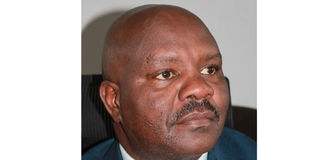So long Kihumba, you inspired many education journalists

The late Kihumba Kamotho.
What you need to know:
- Kamotho’s path and mine are intricately intertwined.
- He was a year ahead of me at Kenyatta University, in the late 1980s, where we both studied Education and specalised in Linguistics.
- Kamotho excelled in his chosen specialty, both at the Nation and the Standard.
Few souls ever grace the stage with the humility of Kihumba Kamotho. Few rise to prominence and carry themselves with reverence and veneration like our fallen colleague, who died this week after a short illness.
Kamotho’s path and mine are intricately intertwined. He was a year ahead of me at Kenyatta University, in the late 1980s, where we both studied Education and specalised in Linguistics.
He later joined Nation Media Group as an Education Writer in the early 1990s and I joined him a year later where we both worked in the Education Desk then under Wamahiu Muya. Education sector was in turbulence in the 1990s and mirrored the evolving political reforms at the time.
In 1991, then President Daniel arap Moi acceded to local and external pressure to reintroduce multiparty politics. Vibrant opposition parties, first Ford under Jaramogi Oginga Odinga and then Democratic Party under Mwai Kibaki, were making waves across the country. Change was in the air.
EDUCATION
Political emancipation released energies across all other sectors. Education was not left behind. In 1990, President Moi had led a delegation to the first World Conference on Education in Jomtien, Thailand. Kenya was being showcased as a country that had nearly achieved 100 per cent enrolment in primary education. Only for the fortunes to take a nosedive.
For a while in the 1980s, Kenya made progress in education, owing to heavy investment. And that was the decade for the establishment of three new universities, Moi, Kenyatta and Egerton, raising the tally to four, together with the University of Nairobi that had been established in 1970.
It was in the 1980s that the government introduced the 8-4-4 following the recommendation of the Collins MaCkay Report of 1981.
KAMUNGE REPORT
But towards the end of the decade and later in the 1990s, things changed for the worse. Following the publication of the report of the Presidential Working Party on Education and Manpower Training for the Next Decade and Beyond in 1988, otherwise known as the James Kamunge Report, the government introduced cost-sharing policy in education. Consequently, it stopped building schools and providing learning and teaching resources. Conversely, the responsibility of providing those resources was pushed on parents.
At the university level, they introduced user fees and abolished students’ stipend, then popularly known as ‘boom’.
For records, the recommendations were influenced by the structural adjustment policies of that generation pushed by the Bretton Wood institutions — World Bank and the International Monetary Fund.
Within a relatively short period of time, the impact began being felt. Enrolments fell drastically in schools as children from poor households were pushed out while at universities, introduction of user fees and cut on subvention to the institutions created a hostile learning environments.
Between 1992 and 1997, for example, universities became permanent theatre for violent student protests.
STUDENT ACTIVISM
Student activism was at its peak. It is during the same period and in tandem with the changed socio-political environment that university lecturers led by Dr Korwa Adar and Dr Kilemi Mwiria (who later became an assistant Minister in Charge of Higher Education under the Narc administration in 2003) formed University Academic Staff Union (Uasu).
That was the era when the Kenya National Union of Teachers, then headed by the distinguished unionist Ambrose Adeya Adongo led teachers for a 12-day strike and planted the seed of what later became a perennial contest between teachers and TSC.
This context provided the environment in which education journalism thrived. And it is this milieu that Kihumba Kamotho plied his trade.
Kamotho excelled in his chosen specialty, both at the Nation and the Standard.
PENCHANT FOR DETAILS
His penchant for details, his fidelity to truth and verification of facts, sobriety of rendition and deep sense of introspection, placed him in a different class. He brought fame, recognition and honour to education journalism.
Leading education journalists of the time and for that matter, of all seasons, were Kamotho, Wachira Kigotho, Munyori Buku, Fred Mudhai, Muthuri Nyamu, Kariuki Waihenya and yours truly. Reporting, analysing and editing education matters required deep insights, thorough research and reflections
When he felt he had done his bit, Kamotho moved on to join the TSC where he served in various capacities but notably distinguished himself, as its Head of Communication and Spokesperson for several years.
At the time of his death, Kamotho and I had been involved in intense conversations of reinvigorating education journalism in the country. Unfortunately, he left the stage before that happened.
That dream lives and we will make come to pass soon. For all us who worked with him, he has left an indelible imprint. In the living words of the poem by Shakespeare: “All the world’s a stage, and all the men and women merely players; they have their exits and entrances.”
Kamotho has left a rich legacy on the stage.
Fare thee well Mwalimu Kihumba Kamotho.




